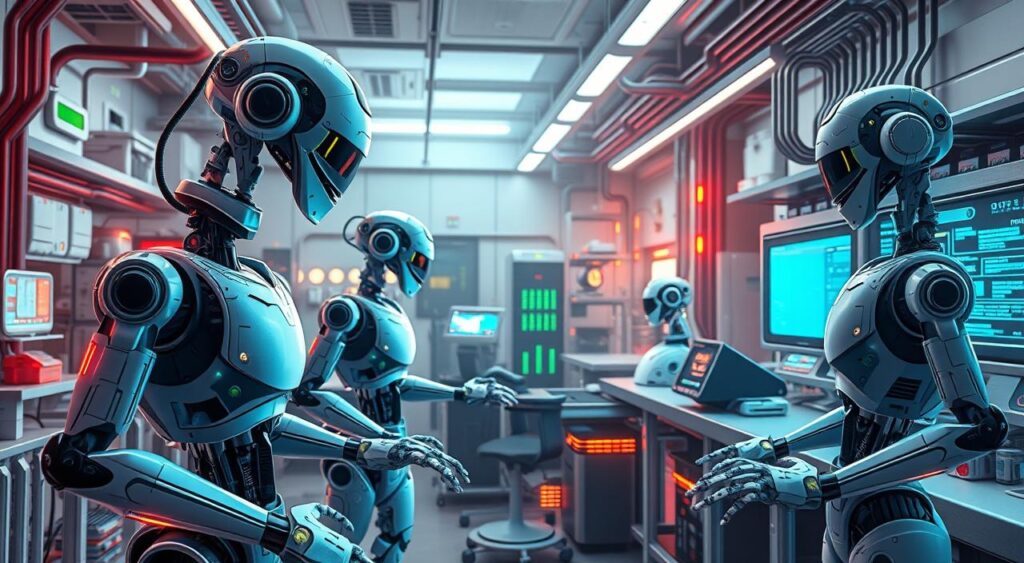Imagine a world where machines can learn, adapt, and make decisions on their own. This is changing how we do business and daily tasks. The rise of agentic AI systems is making this vision a reality, changing what we know about artificial intelligence.
The global AI market is expected to hit $267 billion by 2027, growing fast at 33.2% from 2020 to 2027. By 2023, 37% of companies have started using AI, up from 10% in 2015. This shows how powerful agentic rag is, letting systems work on their own, make tough choices, and keep learning without us.
Agentic AI is all about autonomous agents – smart systems that set their own goals, adjust to new situations, and act on their own to reach their goals. These intelligent assistants use cool tech like reinforcement learning, deep neural networks, and multi-agent systems to handle tough situations, make smart choices, and get better over time.
Key Takeaways:
- Agentic AI is a big step forward in AI, making systems that can work, learn, and adapt by themselves.
- The global AI market is set to hit $267 billion by 2027, showing how agentic workflows can change businesses.
- Agentic AI uses advanced tech like reinforcement learning, deep neural networks, and multi-agent systems to make smart choices and get better.
- Agentic workflows is set to change how we run businesses by adding smart, self-directed systems to our daily work, making things more efficient and smart.
- Getting agentic rag into companies needs careful planning, good data management, and fitting it into current work flows for a smooth start.
The Evolution of Artificial Intelligence: From Traditional to Agentic Systems
Artificial intelligence (AI) has grown from simple systems to ones that make decisions on their own. Now, we have proactive and goal-oriented AI, or agentic AI, which is a big step forward.
Agentic AI uses machine learning and natural language processing to learn and adapt. It can set goals, plan tasks, and find different ways to achieve them. This lets it handle complex tasks and change plans as needed.
Today, agentic AI needs some help or has specific rules. But, the goal is to make AI that can work on its own and solve problems in many ways. These systems can work together, depending on the task and how much human help they need.
Agentic workflows makes companies more efficient and quick to adapt. It’s great for handling big data in finance and healthcare. It helps companies stay ahead by making processes better and responding fast to problems.
The move from old AI to agentic rag is a big step in computing. It could change many industries and how businesses work. Agentic workflows is more flexible and can handle information in a way that’s specific to tasks. It can also get and use information quickly, making decisions and working with other systems.
Agentic AI has parts like sensing, processing, acting, and learning. This lets it do things on its own and get better with time. It’s good for many areas, like healthcare and smart manufacturing.
Adding agentic workflows to systems that can handle many types of data opens up even more possibilities. It can solve complex problems in many fields, from smart cities to healthcare. This evolution of AI is changing how we use technology and solve big challenges.
Understanding Agentic AI and Its Core Components
Agentic AI systems are very independent and can work on their own without needing constant human help. They have special abilities that make them different from regular AI models.
Self-Direction and Goal Setting
Agentic AI can set its own goals based on what needs to be done and the situation. It can figure out the steps to reach its goals and change its plans if needed. This way, agentic workflows can make things more efficient and reduce the need for human help.
Autonomous Decision Making
Agentic AI can make smart choices and take actions based on the situation. It uses big language models to understand complex language. It can also work well with different systems and have meaningful conversations.
It can handle complex tasks and change its plans as things change.
Learning and Adaptation Capabilities
Agentic workflows can learn and adapt quickly using lots of data and powerful computers. It uses methods like reinforcement learning and deep neural networks to get better. This lets it deal with complex situations, predict changes, and improve its plans.
Agentic AI’s abilities in self-direction, decision-making, and learning make it a game-changer in computing. It helps businesses work better, be more productive, and find new chances.
The Transformative Power of AI Agency in Modern Computing
In today’s fast-changing tech world, intelligent agents are changing how we compute. They use cognitive architectures to guess what we need and act on it. This makes systems more efficient and adaptable.
The AI market is expected to grow to $407 billion by 2027, up from $86.9 billion in 2022. This growth comes from new tech like GPT-3 and GPT-4. These models can understand and create text like humans. Reinforcement learning helps AI make smart decisions on its own.
Agentic AI is changing many areas. For example, 10% of cars will be fully self-driving by 2025. AI chatbots can handle 80% of simple customer service, saving up to 30% in costs. By 2028, 15% of work decisions will be made by AI.
Cloud platforms like Microsoft Azure and Amazon Web Services help train and use AI models. Tools like UiPath make it easier to create and use AI agents, helping them spread across industries.
The future of intelligent agents, cognitive architectures, and machine agency looks bright. Agentic rag will change how we live, work, and use technology. It’s bringing us into a new era of smart, responsive, and self-driving computing.
Key Features That Define Agentic AI Systems
Agentic AI systems can make their own decisions, learn as they go, and adjust to their surroundings. They use advanced algorithms and machine learning to understand big data, spot patterns, and make smart choices. They can tackle tough tasks like improving marketing with current data or helping with medical diagnoses by looking at patient records and studies.
Independent Decision-Making Frameworks
At the heart of agentic workflows systems are strong decision-making tools that let them act on their own. These systems can range from simple helpers to fully independent and goal-focused. By letting agentic AI decide for itself, companies can find new ways to be more efficient and creative in many fields.
Real-time Learning Mechanisms
Agentic AI systems can learn and get better in real-time. This ability to adapt is key in changing situations, helping agentic AI to keep improving and getting better results. For example, in customer service, agentic workflows can get better at helping customers with each interaction, making customers happier.
Environmental Adaptation Skills
A big part of agentic AI is its ability to adjust to its environment and keep getting better at what it does. These systems can look at lots of data, find patterns, and change how they act to meet their goals better. This skill is really useful in areas like finance, healthcare, and infrastructure, where agentic rag must follow rules and still do well.
As agentic AI gets better, it will change many industries by making things more efficient, improving customer service, and sparking new ideas. But, we must make sure to use agentic AI wisely, focusing on being open, managing data well, and being ethical.
How Agentic AI Differs from Traditional AI Models
Agentic AI is different from traditional AI because it acts on its own, learns from changes, and plans ahead. It can grow and adapt easily, unlike traditional AI, which often faces scaling challenges. For example, Amazon uses agentic workflows to manage its inventory and logistics, making same-day delivery possible.
Agentic AI is proactive, making decisions and learning from interactions. It uses Large Language Models (LLMs) for natural speech understanding. It also handles complex tasks with powerful computing resources. This AI learns from big datasets, improving over time to tackle dynamic environments.
Agentic AI is great in healthcare, working with doctors to diagnose diseases better. Tools like GoEX and AutoGen help create advanced AI agents. This shift from traditional to agentic workflows marks a big leap in AI capabilities, offering smarter solutions for many fields.
Agentic AI can adjust its strategy based on new information it gets in real time. It works all the time, processing huge amounts of data. This leads to better productivity and lower costs. It’s useful in many areas, like business, healthcare, and finance.
Agentic AI works much faster than humans or teams of researchers. But, it needs a lot of computing power and storage. GitHub Copilot can write up to 60 percent of developers’ code. AI video tools like Tavus offer quick and efficient interactions.
Agentic AI can make better investment decisions for financial trading bots. It can also improve customer service by handling complex interactions. These systems adapt to new information, making them great for dynamic environments. Agentic worklows leads to better efficiency, productivity, and cost savings, making automation scalable.

The Role of Machine Learning in Autonomous Intelligence
Machine learning is key for autonomous intelligence in AI systems. These systems use different machine learning methods to become self-ruling and self-driven.
Reinforcement Learning Applications
Reinforcement learning is a main part of agentic AI. It lets these systems learn the best actions by trying and learning from mistakes. They get better at doing what they’re supposed to do by getting feedback from their surroundings.
Deep Neural Networks Integration
Agentic AI systems also use deep neural networks. These networks help them understand complex data. This way, they can make smarter decisions based on detailed information.
Multi-Agent System Architecture
Many agentic AI systems have a multi-agent setup. Here, different AI agents work together or alone to handle big tasks. This teamwork helps them deal with many challenges and get better at their jobs.
Using machine learning, like reinforcement learning and deep neural networks, is vital for agentic rag. It lets them act on their own and be motivated. This technology is a big leap in AI, ready to change many fields.
Applications and Use Cases Across Industries
Agentic AI has changed the world of computing, with many uses in different fields. In high-frequency trading, AI makes thousands of trades per second. Tesla’s cars also use AI for better navigation and decisions.
Businesses are quickly using agentic workflows to make their work easier. GitLab uses AI to write code and test it. Amazon, Cisco, and AT&T are using AI to automate content creation. A Dutch insurer has automated 90% of its auto claims with AI.
More companies will use agentic AI in the future. Gartner says AI will write most code in three years. Forrester calls Agentic AI a top tech for 2025. Aflac, Atlantic Health System, Legendary Entertainment, and NASA are already using it.
Agentic AI is used in many ways, from making work easier to improving security. It also helps employees make better decisions with data.
As more companies use agentic AI, many industries will see big changes. These AI systems work well with current tech, making businesses more innovative and successful.
Implementation Challenges and Solutions
Setting up agentic AI systems is tough for companies. They need the right tech setup. For example, Klarna uses AI to handle most customer service, like 700 people. This helps with rules and saves money by spotting problems early.
Companies need strong computers, lots of storage, and fast data handling. This is key for AI to work well.
Dealing with data is another big challenge. AI uses a lot of data, which raises privacy and security worries. There’s also the risk of AI being unfair if the data it learns from is biased.
Keeping data good and fair is vital. Good data management is crucial for AI to perform well.
Security Considerations
AI security is a big deal. As AI gets more advanced, so do the threats. It’s also hard to understand why AI makes certain choices.
Fixing these issues is key to making AI work. Companies need to think about tech, data, and security all together. With the right steps, they can use AI’s power without big risks.

The Impact of Agentic AI on Business Operations
Agentic AI is changing how businesses work, making them more efficient and scalable. These AI systems can work on their own, perfect for tasks that need constant watching or quick decisions. They can manage supply chains, keep inventory levels right, predict demand, and plan logistics, all on their own.
In healthcare, AI agents can help patients every day, watch their health, change treatment plans as needed, and spot health problems early. In software making, AI agents can speed up work by handling development, designing systems, writing code, and checking quality. They also boost security by watching network traffic, finding oddities, and fighting off cyber threats without needing people to watch all the time.
The finance world is also set for big changes with agentic AI. AI agents can look at market trends, make quick trading choices, and adjust investment plans based on current economic data. In HR, AI agents can make hiring easier, schedule interviews, help new employees get started, train them, and check how they’re doing. AI can really change how companies find and keep talent, from first meetings to helping with career growth.
But, there are also big challenges with agentic AI. Making sure AI systems act like we want them to is a big issue. The ‘black box’ problem, where we can’t understand how AI makes decisions, makes it hard to trust and hold accountable. Keeping data safe and private is also a big worry, since AI systems deal with sensitive info on their own.
Despite these challenges, agentic AI is making a big difference in business. As companies try to use AI to improve and grow, more will start using these smart systems. This will change how businesses work and compete today.
| Key Metrics | Adoption Rates | Benefits Realized |
|---|---|---|
| 55% of global organizations now use Generative AI in at least one business function | 42% of surveyed organizations report cost reductions from implementing AI | 59% report revenue increases from AI implementation |
| $67.2B was invested in GenAI alone in the United States in 2023 | Agentic AI can improve employee productivity by as much as 40% | Agentic AI enhances customer satisfaction by automating interactions and providing personalized experiences |
Adding agentic AI to business operations is tough, but the benefits are huge. It can save money, make decisions better, and make businesses more efficient. It’s a key technology that smart companies can’t ignore.
Ethical Considerations and Responsible Development
As AI systems get more independent, we must focus on ethics and rules. It’s key to make sure AI acts right and follows the law. This builds trust and keeps AI safe and useful.
There’s a big worry about AI being unfair. For example, facial recognition often fails for women and darker-skinned people. This can cause harm and unfair treatment. It’s important to be open and fair in AI to avoid these problems.
AI art also brings up tricky questions about who owns it. Humans used to own art, but AI art changes that. We need clear laws about who owns AI art and how to share profits. Copyright laws help protect creators, but AI art challenges these rules.
Companies like Salesforce are tackling these issues. They have rules for safe AI use. Salesforce’s Agentforce checks for bad content and is clear about what it does. They aim to make AI that works well with humans and is trustworthy.
As AI gets more common, we need to work on rules and ethics together. By focusing on safe AI, we can use its power for good. This way, we avoid problems and make sure AI helps us all.
Future Prospects and Technological Advancements
The future of agentic AI looks bright, with new tech and research leading the way. We can expect better decision-making, learning, and adapting to the environment. For example, ambient intelligence has shown an 87% accuracy in ICU settings, which could cut ICU-acquired weaknesses by 40%.
Virtual Reality Exposure Therapy (VRET) for PTSD has seen success rates from 66% to 90%. This shows how AI can help treat certain conditions.
Emerging Technologies
New technologies, like polyfunctional robots, are making big strides in robotics. These robots can do many tasks, showing how fast robotics is improving. They promise to change industries like healthcare and manufacturing by making things more efficient and adaptable.
Research Directions
Researchers are working hard to make AI systems more independent and efficient. They’re looking into better reinforcement learning, supervised learning, and multi-agent systems. These advancements aim to solve complex problems in different areas.
Potential Breakthroughs
The future of agentic AI looks even more promising, with more autonomy and problem-solving skills. By 2028, a third of enterprise software will use agentic AI, says Gartner. As companies use this tech, AI systems engineers will play a key role in making sure AI works right and is trustworthy.
The field of agentic AI is growing fast, with open-source projects leading the way. They’re working on multi-agent protocols, communication, and security tools. As AI gets better, it could change industries and how we use technology in exciting ways.
Integration Strategies for Enterprise Adoption
The business world is now embracing artificial intelligence (AI) more than ever. Integrating AI systems into business operations is a top priority. Gartner predicts that by 2028, 33% of enterprise software applications will include AI. McKinsey’s whitepaper highlights how AI systems can plan, collaborate, and learn to improve.
Integrating AI into businesses needs careful planning and expertise. Working with AI consulting services can help align AI systems with business goals. In 2024, less than 1% of enterprise software included AI, but this is expected to grow by 2028.
Starting with small projects and encouraging learning are key to adopting AI in business. Advanced systems like FAISS help AI agents process large data sets, aiding in document processing and recommendations. AI agents are the next step in transforming businesses.
- Identify high-impact use cases: Find areas where AI can add the most value, like improving decision-making or customer service.
- Establish a clear roadmap: Plan how to integrate AI into your systems, considering data, infrastructure, and training needs.
- Foster a culture of AI-readiness: Encourage a mindset of continuous learning and adaptation among your team.
- Collaborate with AI experts: Work with AI consulting services to ensure a smooth integration of AI into your business.
- Start small, scale smart: Begin with pilot projects to show the value of AI, then expand as you learn and refine your strategies.
| Key Considerations for Agentic AI Integration | Benefits |
|---|---|
| Identifying high-impact use cases | Maximizing the strategic value of agentic AI within the organization |
| Establishing a clear implementation roadmap | Ensuring a seamless and well-coordinated transition to agentic AI |
| Fostering a culture of AI-readiness | Empowering employees to embrace and collaborate with agentic AI systems |
| Collaborating with AI experts | Leveraging specialized knowledge and experience for successful integration |
| Starting with targeted pilot projects | Demonstrating the value of agentic AI and scaling it effectively |
By adopting these strategies, businesses can use AI to innovate, improve efficiency, and lead in the changing business world. AI agents will change industries like finance, healthcare, and tech because they adapt well to changing environments.
Integrating AI into businesses is a journey that needs a strategic and team effort. By working with AI experts, promoting learning, and following a detailed plan, companies can unlock AI’s full potential and succeed in the long run.
Conclusion
Agentic AI is changing the game in artificial intelligence, impacting business and society. It’s evolving fast, promising to boost ai-driven innovation and efficiency. This opens up new chances in many fields. Companies must use this tech wisely to stay ahead in the agentic ai future.
Agentic AI systems are making big strides in computing. They can make decisions, learn quickly, and adapt to their surroundings. This is thanks to advances in machine learning and AI architecture.
As agentic AI becomes more common, companies face new challenges. They need to focus on ethical and secure use. By combining human skills with AI, businesses can achieve great things. This puts them in a strong position for the agentic ai future.







